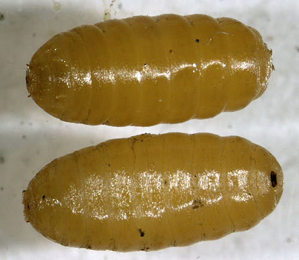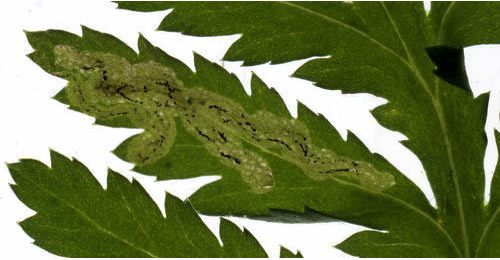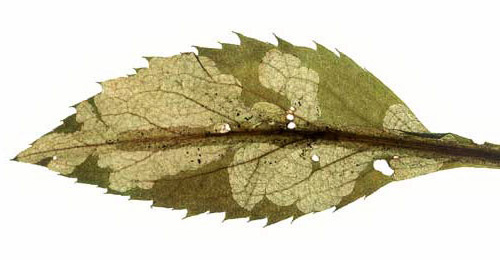|
||||||
|
CHRYSANTHEMUM. Crown Daisy and Corn Marigold [Asteraceae] |
|
|
Two species of Chrysanthemum are recorded in Britain the introduced Crown Daisy (C. coronarium) and Corn Marigold (C. segetum). C. coronarium is treated as Glebionis coronarium and C. segetum is treated as Glebionis coronarium by Stace (2010). Ten or eleven British miners are recorded on Chrysanthemum. The tortricid Cnephasia conspersana is recorded as a seed / shoot feeder on Chrysanthemum in Britain. A key to the European miners recorded on Chrysanthemum is provided in Bladmineerders van Europa. |
 Corn Marigold Chrysanthemum segetum |
Key for the identification of the known mines of British |
||
1a > Leaf-miner and case-bearer: The larva lives outside the mine, protected by a case, and feeds on the underlying plant tissues via a hole cut in the epidermis. From that point it eats away as much leaf tissue as it can reach without fully entering the mine. Mine does not contain frass (Coleophora species). A relatively large (12-15 mm), dark brown, lightly curved two-valved sheath case with a narrow ventral keel. Mouth angle 30-45. |
||
|
||
Coleophora conspicuella Zeller, 1849 [Lepidoptera: Coleophoridae]. |
||
1b > Leaf-miner, but not a case-bearer: |
||
2a > Leaf-miner: The mine begins as an elongated blotch overlying a strong vein; from there broad tunnels radiate that coalesce in the end. All frass is concentrated at a central point in the floor of the mine. As a result the mine has a brownish-black centre and a paler brownish green seam. The larva often (perhaps always at daylight) rests in the centre of the mine. Primary and secondary feeding lines as a rule quite clear. Pupation outside the mine. An elongated blotch centred over a vein. There are two types: greenish with a blackish centre and entirely reddish-black. |
||
 Trypeta artemisiae pupariria Image: © Willem Ellis (Bladmineerders van Europa) |
||
|
||
Trypeta artemisiae (Fabricius, 1794) [Diptera: Tephritidae]. |
||
2b > Leaf-miner: The larva feeds in a leaf-mine to begin with, then later feeds externally on the leaves, shrivelling and blanching or browning them. Initially an extremely fine corridor along the leaf margin; these mines mainly in the lower leaves. Frass in a narrow central line. The larva can leave its mine and restart elsewhere. Older larvae live free, and feed by slicing open the margin of a leaf segment near its tip and eating away as much tissue as it can reach (to about one third if its body length). The result is a number of full depth blotch mines. When the larva has become too large even for this strategy, its starts to feed freely on the leaf. The larva pupates in a distinctive whitish ribbed cocoon. |
||
|
||
Bucculatrix cristatella (Zeller, 1839) [Lepidoptera: Bucculatricidae]. |
||
2d > Leaf-miner: In the first instar the larva mines the leaves, forming short, irregular, blotch-like mines, but in later instars it lives externally, feeding in spun leaves and often twisting those of tender shoots. Larval head light-brown or yellowish brown, edged with black postero-laterally, ocellar area blackish; prothoracic plate black edged with whitish anteriorly; abdomen dull dark green; pinacula distinct, black, sometimes brownish but with black bases to setae; anal plate large, black (Bradley et al., 1973). Small, full depth mine without a definite shape; little frass. Some silk is deposited in the mine. The larva soon leaves the mine and continues feeding among spun leaves. |
||
|
||
Cnephasia incertana (Treitschke, 1835) [Lepidoptera: Tortricidae]. |
||
2e >Leaf-miner: Linear mine. |
||
3a > Leaf-miner: A narrow linear mine, with frass in black strips (Spencer, 1972b: 57; Spencer, 1976: 274). Narrow upper-surface corridor. The corridor often follows nerves, causing it to branch now and then. Frass in strings. Pupation outside the mine. Puparium yellowish-black. |
||
 Mine of Liriomyza tanaceti on Tanacetum vulgare Image: © Willem Ellis (Bladmineerders van Europa) |
||
|
||
Liriomyza tanaceti Meijere [Diptera: Agromyzidae]. |
||
3b > Leaf-miner: Mine not primarily associated with the mid-rib. Mine linear, whitish, both upper and lower surface. Pupation internal, at the end of the mine with the anterior spiracles projecting through the epidermis (Spencer, 1976: 433). Upper-surface, less often lower-surface corridor. Frass in isolated grains. Pupation within the mine, usually in a lower-surface puparial chamber. A long whitish upper surface corridor, which eventually goes lower surface. |
||
|
||
Chromatomyia
horticola (Goureau, 1851) [Diptera: Agromyzidae] |
||
3c > Leaf-miner: Mine irregularly linear, whitish, distinctly widening, most frequently on lower leaves. Pupation external (Spencer, 1972b: 79). Long, slender corridor, gnerally upper-surface with a lower-surface beginning. Frass in irregular, but not conncted, grains. Pupation outside the mine. A long, irregular galley which widens distinctly, upper surface, but often starting lower surface and sometimes forming a secondary blotch. Most frequently on lower leaves. |
||
|
||
Phytomyza leucanthemi Hering, 1935 [Diptera: Agromyzidae]. |
||
3c > Leaf-miner: Mine primarily associated with the mid-rib. |
||
4a > Leaf-miner: A distinctive mine primarily above mid-rib, with irregular short lateral offshoots into leaf blade. Pupation external (Spencer, 1972: 51 (fig. 172), 55; Spencer, 1976: 270, 271 (fig. 486)). Branched, whitish, upper-surface corridor; main axis overlying the midrib; side branches overlying the main lateral veins. (In Campanula and Phyteuma the mine is much less branched, sometimes nothing more than a corridor on top of the midrib). Frass in rather long strings. Usually the mines begins as a long and narrow, shallow, tortuous lower-surface corridor that ends upon the midrib but otherwise is not associated with the leaf venation. Often this initial corridor is filled with callus, and then even less conspicuous. Pupation outside the mine. A linear mine on the upper surface, usually following the midrib and showing side branches along the veins. The frass is in strings. |
||
|
||
|
||
Liriomyza strigata (Meigen, 1830) [Diptera: Agromyzidae]. |
||
4b > Leaf-miner: A broad linear mine following the mid-rib, with irregular lateral offshoots. Puparium yellow |
||
|
||
Trypeta zoe Meigen, 1826 [Diptera: Tephritidae]. |
||
4c > Leaf-miner: Broad corridor overlying the midrib. The mine has a number of side branches that distally widen strongly, and may coalesce. Primary and secondary feeding lines very conspicuous. Pupation external, in soil. |
||
 Mine of Cornutrypeta spinifrons on Senecio ovalis Image: © Willem Ellis (Bladmineerders van Europa) |
||
|
||
Cornutrypeta spinifrons (Schroeder, 1913) [Diptera: Tephritidae]. |
||
| Last updated 09-Jul-2020 Brian Pitkin | ||

